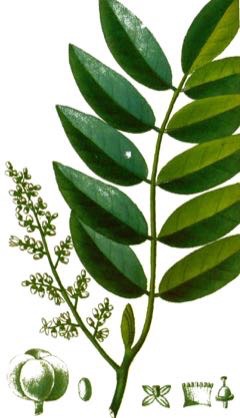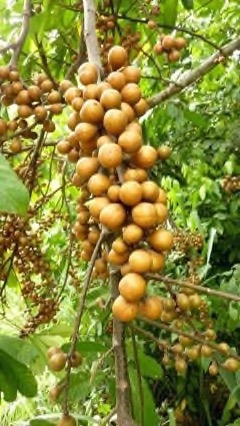 |
|
http://www.edibleplants.org |
 |
| Flickr - Alex Popovkin |
Translate this page:
Summary
Muskwood or Guarea guidonia is an evergreen tree growing up to 23 m in height with trunk diameter of up to 90 cm. It has a straight bole and a large, dense, roundish crown. The leaves are compound. The fruit is a capsule. The seeds are covered with an orange red pulp. Muskwood can be found in South America. It is harvested from the wild for medicinal purposes and timber. Conditions like angina, asthma, dyspnoea, vomiting, infant?s thrush, and body aches can be treated using different plant parts and forms of Muskwood. It also provides shade in coffee plantations. Reddish Sandal oil is obtained from the wood. The wood is ideal for furniture, cabinets, construction, window frames, carpentry, etc.
Physical Characteristics

 Guarea guidonia is an evergreen Tree growing to 15 m (49ft) by 12 m (39ft) at a slow rate.
Guarea guidonia is an evergreen Tree growing to 15 m (49ft) by 12 m (39ft) at a slow rate.
See above for USDA hardiness. It is hardy to UK zone 10.
It is noted for attracting wildlife.
Suitable for: light (sandy), medium (loamy) and heavy (clay) soils and prefers well-drained soil. Suitable pH: mildly acid, neutral and basic (mildly alkaline) soils. It can grow in semi-shade (light woodland) or no shade. It prefers moist soil.
UK Hardiness Map
US Hardiness Map
Synonyms
Guarea alba C.DC. Guarea alternans C.DC. Guarea andreana C.DC. Guarea aubletii A.Juss. Guarea bilibi
Plant Habitats
Edible Uses
References More on Edible Uses
Medicinal Uses
Plants For A Future can not take any responsibility for any adverse effects from the use of plants. Always seek advice from a professional before using a plant medicinally.
Abortifacient Antiasthmatic Cardiac Emetic Emmenagogue Expectorant Haemostatic Purgative
Styptic
A decoction of the whole, crushed plant is drunk as a treatment for angina, asthma and dyspnoea[348 ]. The resin obtained from the leaves and the stem, as well as the pulverised bark, is used locally as styptic[317 ]. The stem bark is emetic (in larger doses), expectorant, haemostatic and purgative[46 , 317 , 348 ]. A decoction is used to induce vomiting and to treat infant's thrush[348 ]. Applied externally, the powdered bark is used as a haemostatic to stem bleeding[46 ]. The liquid obtained from the rasped bark is rubbed onto skin in order to relieve body aches[348 ]. The boiled leaves are used as an emetic[348 ]. The bark contains the alkaloid rusbyine[46 ]. A juice obtained from the roots and stems is abortifacient, emmenagogue, purgative and violently emetic[348 ]. The juice is a corrosive poison which can be counteracted by an infusion of buds of Jatropha curcas[348 ]. Extracts of the bark and wood contain beta-sitosterol[348 ]. The seed contains angustinolide, a tetranotriterpenoid[348 ].
References More on Medicinal Uses
The Bookshop: Edible Plant Books
Our Latest books on Perennial Plants For Food Forests and Permaculture Gardens in paperback or digital formats.

Edible Tropical Plants
Food Forest Plants for Hotter Conditions: 250+ Plants For Tropical Food Forests & Permaculture Gardens.
More

Edible Temperate Plants
Plants for Your Food Forest: 500 Plants for Temperate Food Forests & Permaculture Gardens.
More

More Books
PFAF have eight books available in paperback and digital formats. Browse the shop for more information.
Shop Now
Other Uses
Essential Furniture Wood
Agroforestry Uses: The tree is cultivated in an agroforestry system on Haiti together with coffee, bananas and other species[317 ]. In Puerto Rico it is considered to give too dense a shade for growing with coffee[447 ]. Other Uses: A reddish Sandal oil is obtained from the wood[46 ]. (refers to G. trichilioides, a synonym of this species.) The very attractive heartwood is pinkish to red, turning light reddiish brown; the sapwood is whitish to brownish. The texture is medium, grain is straight; aromatic when green though odourless when seasoned. The wood is of medium weight to moderately heavy; hard; strong; tough; elastic to somewhat brittle; and very durable, even when in wet ground, with resistance to attack by dry-wood termites. Rate of air-seasoning is slow, and amount of degrade is moderate. Machining characteristics are as follows: planing, shaping, turning, mortising, and resistance to screw splitting are good; boring is fair; and sanding is excellent. This pretty wood makes fine furniture and cabinets, since it resembles mahogany and Spanish-cedar and takes a high polish. It is used also for construction, internal works, window frames, carpentry, implements, cooperage etc[46 , 333 , 419 , 447 ]. The wood is a favoured fuel because it splits easily[922 ].
Special Uses
Attracts Wildlife
References More on Other Uses
Cultivation details
Prefers a sunny position[419 ]. Newly planted young trees are fairly slow-growing[419 ]. Plants can flower and produce fruit for most of the year[447 ]. Flowering Time: Late Winter/Early Spring Mid Spring Late Spring/Early Summer Mid Summer Late Summer/Early Fall. Bloom Color: White/Near White. This plant is attractive to bees, butterflies and/or birds.
References Carbon Farming Information and Carbon Sequestration Information
Temperature Converter
Type a value in the Celsius field to convert the value to Fahrenheit:
Fahrenheit:
The PFAF Bookshop
Plants For A Future have a number of books available in paperback and digital form. Book titles include Edible Plants, Edible Perennials, Edible Trees,Edible Shrubs, Woodland Gardening, and Temperate Food Forest Plants. Our new book is Food Forest Plants For Hotter Conditions (Tropical and Sub-Tropical).
Shop Now
Plant Propagation
Seed - it has a short viability and should not be allowed to dry out, nor should the aril surrounding the seed be removed[419 ]. Sow the seed as soon as it is harvested in a lightly shaded position, either in a nursery seedbed or in individual containers. Germination rates are usually low, with the seed sprouting within 30 - 50 days[419 ].
Other Names
If available other names are mentioned here
Muskwood , Carrapeta, Cedro Macho, ball-wood, bois balé, cocillana, cocillana tree, cocillana tree#, guaraguao, guarea, guarea trichilioides, huapi bark, jitó, macaqueiro, muskwood, pamasuki, red-wood, requia.
Native Plant Search
Search over 900 plants ideal for food forests and permaculture gardens. Filter to search native plants to your area. The plants selected are the plants in our book 'Plants For Your Food Forest: 500 Plants for Temperate Food Forests and Permaculture Gardens, as well as plants chosen for our forthcoming related books for Tropical/Hot Wet Climates and Mediterranean/Hot Dry Climates. Native Plant Search
Found In
Countries where the plant has been found are listed here if the information is available
Nicaragua; Costa Rica; Panama; Cuba; Haiti; Dominican Republic; Puerto Rico; Virgin Islands, U.S.; Colombia; Venezuela, Bolivarian Republic of; Guyana; Suriname; French Guiana; Brazil; Ecuador; Peru; Bolivia, Plurinational State of; Paraguay, Central America, North America, USA,
Weed Potential
Right plant wrong place. We are currently updating this section.
Please note that a plant may be invasive in one area but may not in your area so it’s worth checking.
Conservation Status
IUCN Red List of Threatened Plants Status : This taxon has not yet been assessed

Growth: S = slow M = medium F = fast. Soil: L = light (sandy) M = medium H = heavy (clay). pH: A = acid N = neutral B = basic (alkaline). Shade: F = full shade S = semi-shade N = no shade. Moisture: D = dry M = Moist We = wet Wa = water.

Expert comment
Author
(L.) Sleumer
Botanical References
1
Links / References
For a list of references used on this page please go here
A special thanks to Ken Fern for some of the information used on this page.
Readers comment
| Add a comment |
|
If you have important information about this plant that may help other users please add a comment or link below. Only comments or links that are felt to be directly relevant to a plant will be included. If you think a comment/link or information contained on this page is inaccurate or misleading we would welcome your feedback at [email protected]. If you have questions about a plant please use the Forum on this website as we do not have the resources to answer questions ourselves.
* Please note: the comments by website users are not necessarily those held by PFAF and may give misleading or inaccurate information.
To leave a comment please Register or login here All comments need to be approved so will not appear immediately.
|
Subject : Guarea guidonia
|
|
|
|